Carlos Corberán has quickly established himself as one of the most intriguing tactical minds in modern football. After impressing with his work at Huddersfield Town and West Bromwich Albion, the Spanish coach has now taken the reins at Valencia, bringing his dynamic and innovative approach to La Liga.
In this tactical analysis, we will explore the key principles that define Corberán’s philosophy at Valencia, focusing on his pressing structures, build-up strategies, and attacking patterns. We will also examine how his tactical choices influence Valencia’s performances and assess their effectiveness against different opponents.
By delving into Corberán’s methods, we aim to understand how he is shaping the team’s identity and whether his approach can restore Valencia to the upper echelons of Spanish football.
Build-up
Low Build-up
In the low build-up, Corberán usually sets his team up in a 4-2-2-3 formation, with the goalkeeper pushing up into the backline, two holding midfielders, two attacking midfielders, and a front three up top.
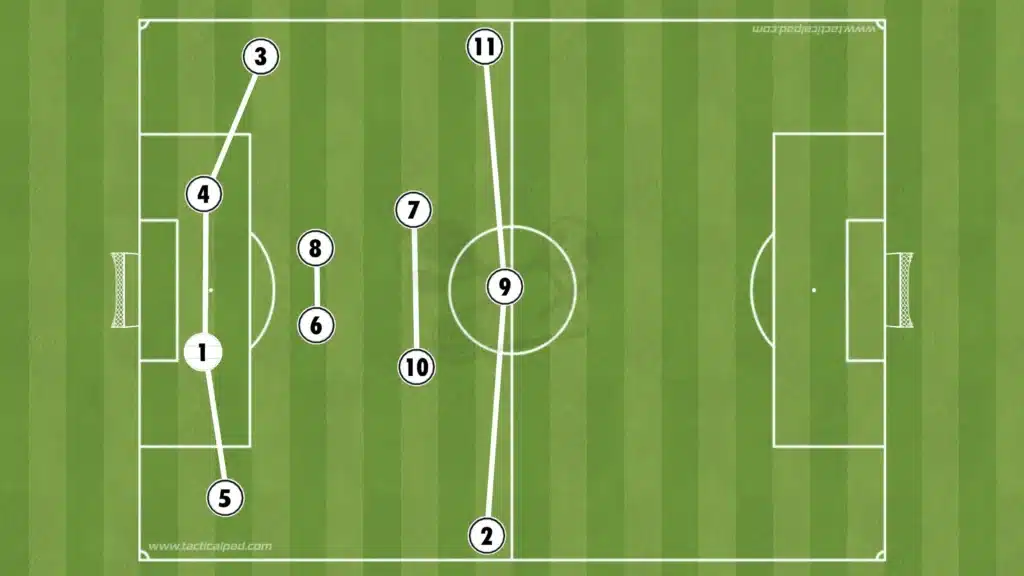

Corberán mainly wants his team to beat the opposition’s press by finding an attacking midfielder in the space between the opposition’s defense and midfield, who can bounce the ball to a holding midfielder, who then can progress the ball forward. When Valencia beat the press, the attackers will immediately make runs in behind, looking to exploit the space behind the opposition’s backline.
The Valencia players are also not afraid to be more direct in the low build-up. If the opposition comes up and presses man-to-man, there will be numerical equality up top with the Valencia attackers against the opposition defenders. The goalkeeper will often find an early longer ball up to the attackers, aiming to win 4v4 or 3v3 situations. The Valencia attackers have good individual quality and will often win these battles to create goalscoring opportunities.
High Build-up
In the high build-up, Corberán wants his team to play in a 1-3-2-2-3 formation.
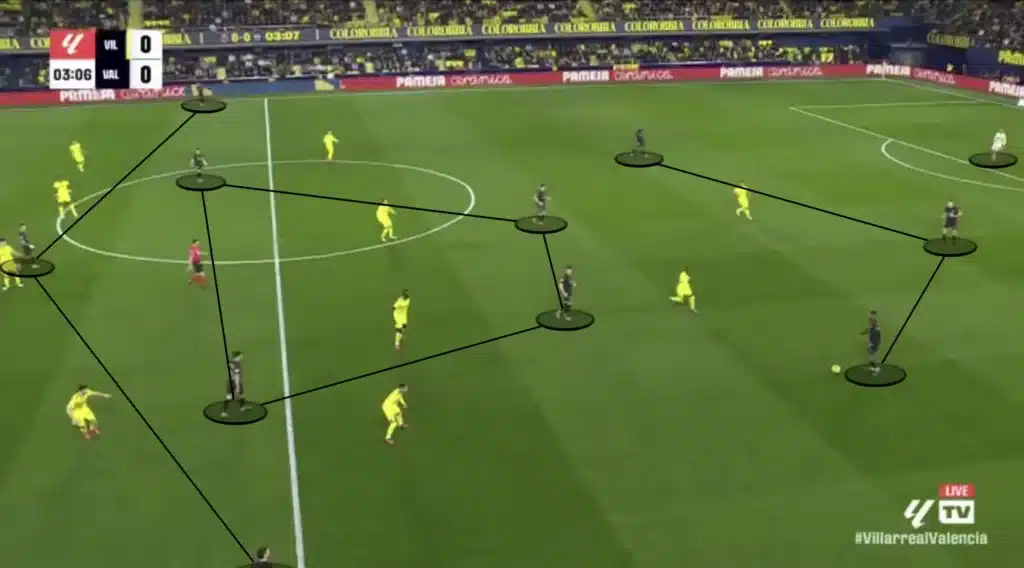
Building up in a 1-3-2-2-3 formation focuses on creating numerical superiority and controlled progression. The back three provide stability and width, while the two holding midfielders sit in front to offer passing options and protect against counterattacks. The two attacking midfielders position themselves between the opposition’s midfield and defensive lines, creating central overloads and linking play. The front three stretch the field horizontally, with wingers staying wide and the striker occupying central defenders.
Staggered Midfield
Corberán usually wants the two holding midfielders to be in different lines during the build-up. This is crucial for creating passing lanes and disrupting the opposition’s defensive structure.
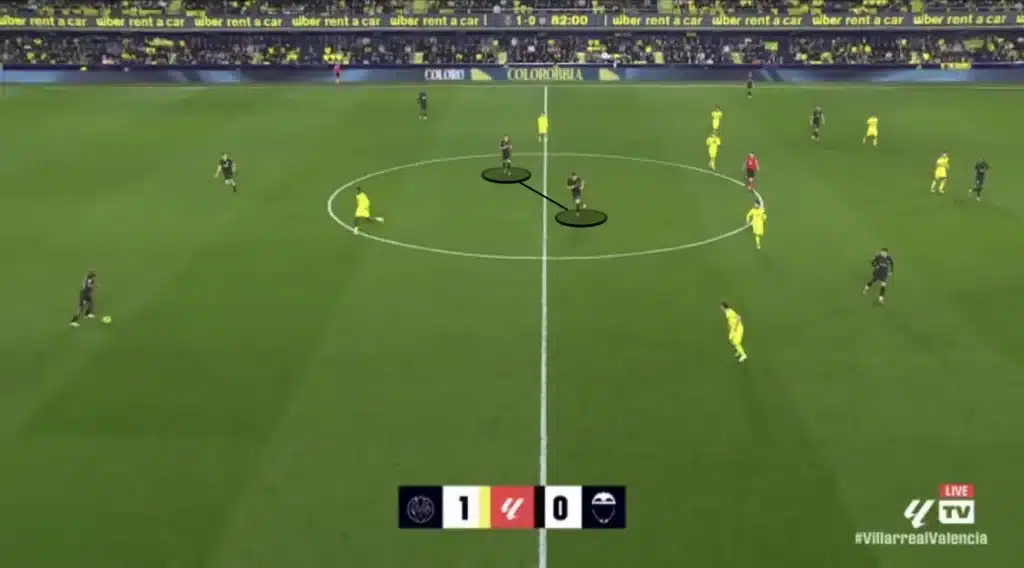
When the holding midfielders are staggered—one slightly ahead of the other—it forces the opposition’s attackers to make difficult decisions on who to block off, opening up space for the team to advance the ball. This layered positioning also enhances ball circulation by providing multiple angles for passing, reducing the risk of predictable or intercepted passes. The holding midfielders can play between themselves, allowing them to find third-man combinations to beat the opposition’s first line of pressure.
Numerical Advantages in the Middle
In the 1-3-2-2-3 formation, there will be a winger wide on each side, and the remaining eight players will be in the center. This means Valencia will almost always be numerically superior to the opponent in the midfield. Corberán likes this because he prioritizes playing through the middle. He needs one player out wide to pull the opposition apart while the rest create numerical advantages in the midfield areas.
When a team outnumbers the opposition in the midfield, it can more easily retain the ball, exploit spaces, and progress the ball through the center. Valencia will often progress the ball through quick central passes between the midfielders, beating the opposition’s press and exploiting gaps in the defense.
Another purpose for keeping many players in the middle is to shorten the distance between them. This shortens the length of the passes, which naturally shortens the time between passes. This means the opposition players will have less time to push up and press, giving the Valencia players more time and control.
Rest-Defence
Corberán also wants many players close to the center to create a good rest-defence structure. Rest-defence in football refers to a team’s defensive organization and structure when they have possession of the ball, specifically aimed at being prepared to defend immediately if they lose it. A good rest-defence structure is crucial for maintaining balance and preventing counterattacks when the team is in possession.
Having many players in the middle and close to the ball gives Valencia a good rest-defence, since it allows more players to counterpress when they lose the ball. When losing possession, the four or five Valencia players closest will immediately jump on the opposition player with the ball and close the distance to cut off any passing lanes. This approach disrupts the opponent’s transition from defense to attack, forcing errors and creating opportunities to regain control of the ball.
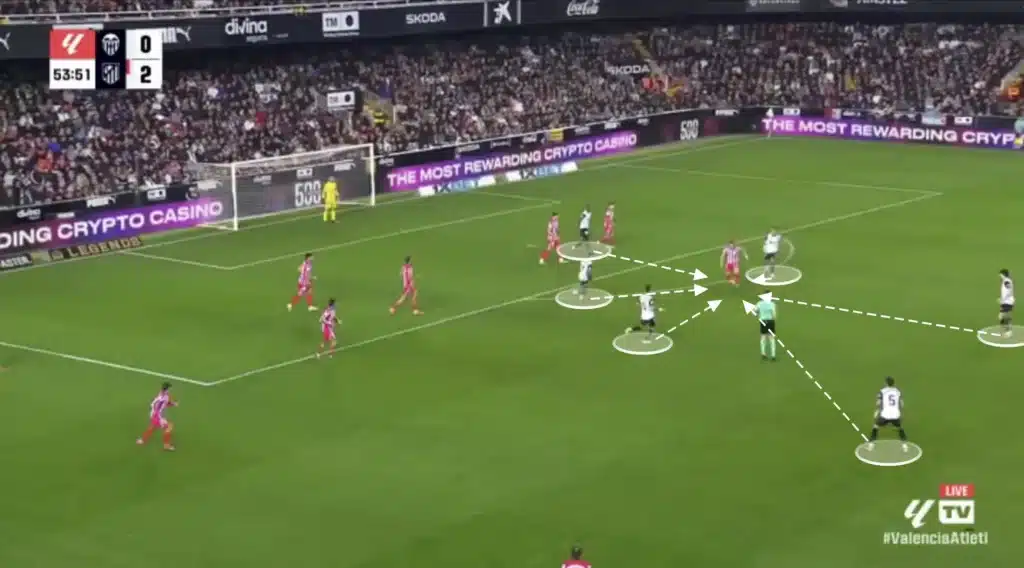
Counterpressing like this keeps Valencia on the front foot, allowing them to dominate possession and create more scoring opportunities. However, it requires exceptional fitness, tactical discipline, and teamwork.
Third-Man
Corberán wants his team to play through the opposition when possible. One vital tool they often use to do this is the third-man principle. The third-man principle is a tactical concept used to create and exploit space by involving a third player in a passing sequence.
It typically works by having Player A pass the ball to Player B, who then quickly relays it to the free Player C. An opponent will block the pass from Player A to Player C, but the pass from Player B to Player C will be open, which is why he is needed in this passing combination.
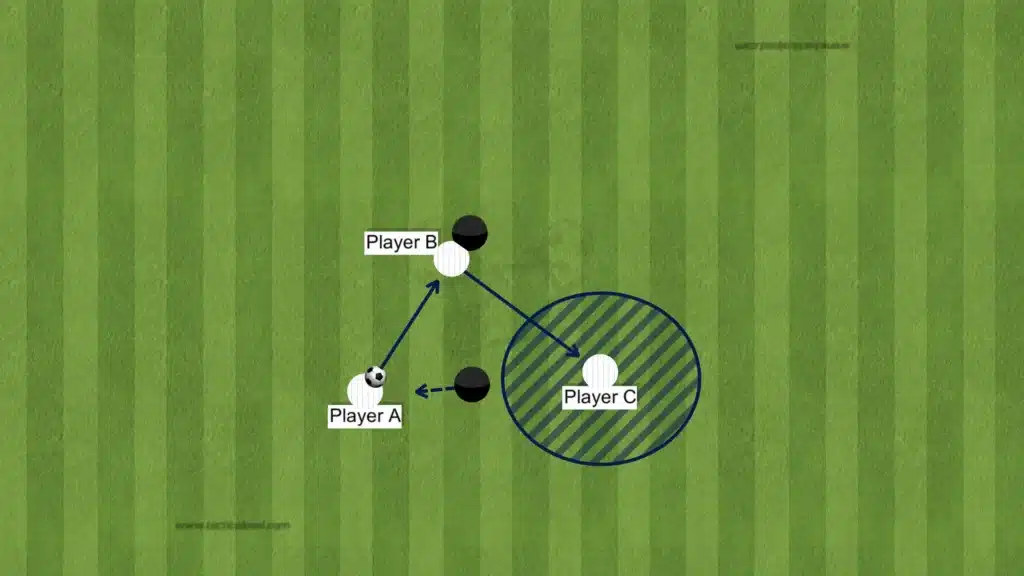
This movement often bypasses an opponent’s pressing line and opens up space, allowing the team to advance the ball more effectively. The key to the third-man principle is timing and positioning, as the third player must anticipate the play, position themselves advantageously, and receive the ball in a manner that breaks the opposition’s defensive structure. This principle is integral to many modern football strategies, promoting fluidity, quick decision-making, and dynamic attacking play.
Valencia will, for example, use third-man combinations involving the attacking midfielders to find an open holding midfielder in between the lines.

When they find their midfielders in these spaces, the attackers will immediately make runs in behind the opposition backline, looking to quickly get into goalscoring positions. They will especially look for diagonal balls to the opposite attacking midfielder, who will make a run in behind on the blindside of the opposition center-backs.
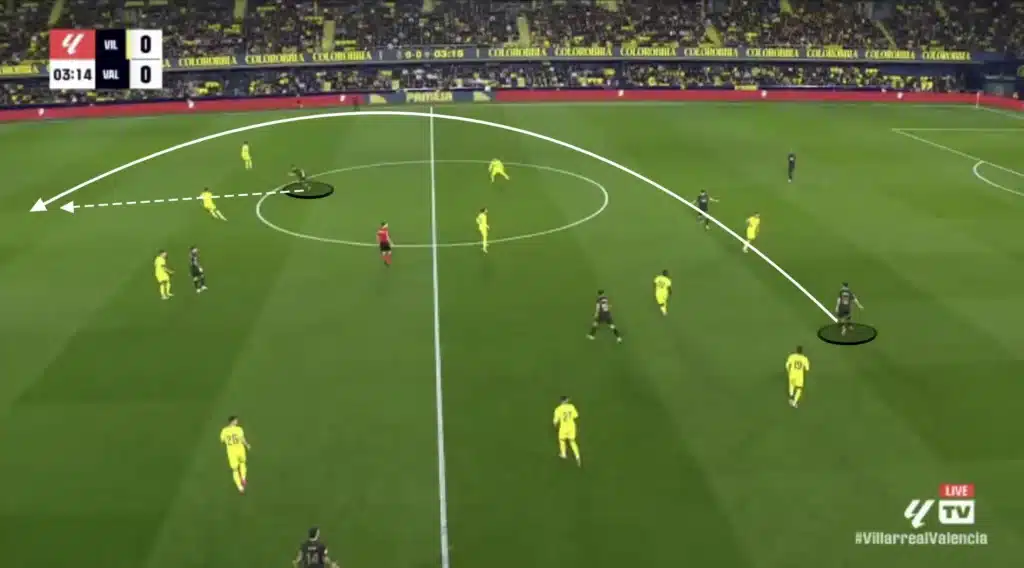
Progression Through Wide Center-Backs
A key aspect of Valencia’s high build-up under Carlos Corberán is progressing the ball through the wide center-backs. Rather than always relying on central passes through congested areas, Corberán encourages his wide center-backs to drive the ball forward on the outside of the opponent’s forward line. This approach helps stretch the opposition’s defensive structure horizontally while maintaining controlled possession.
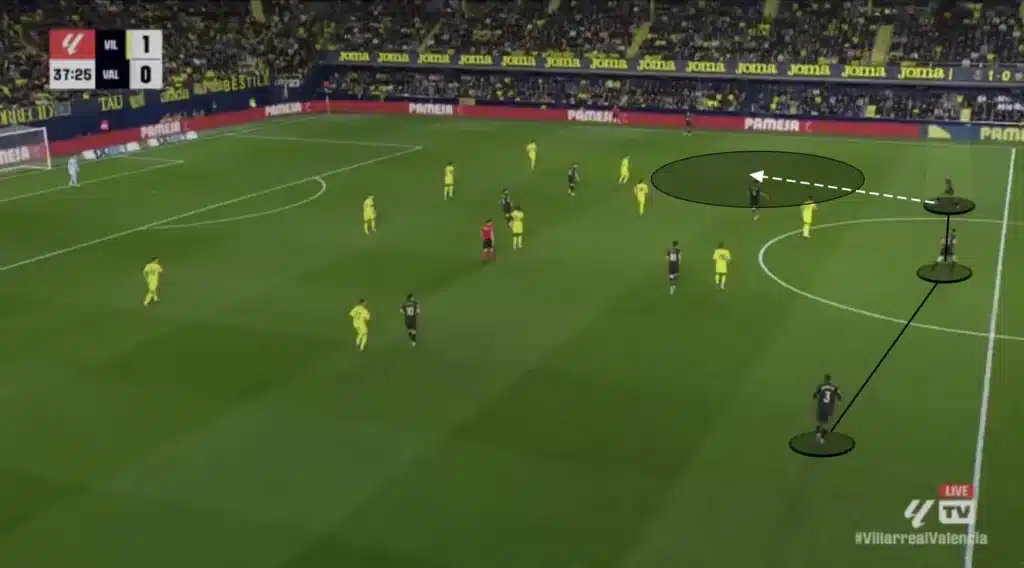
By advancing up the outside of the forward line, the wide center-backs force the opposition’s wide attackers to either follow them out—creating gaps centrally—or remain passive—allowing unchallenged progression. This movement not only disrupts the opponent’s pressing shape but also positions the ball in areas where line-breaking passes become more accessible.
Once the wide center-back has moved up the flank, they will look to play penetrating passes into the attacking midfielders, who position themselves in the pockets of space between the opposition’s midfield and defensive lines. These passes are crucial for breaking through the opponent’s defensive block, as they bypass multiple lines of pressure in one motion.
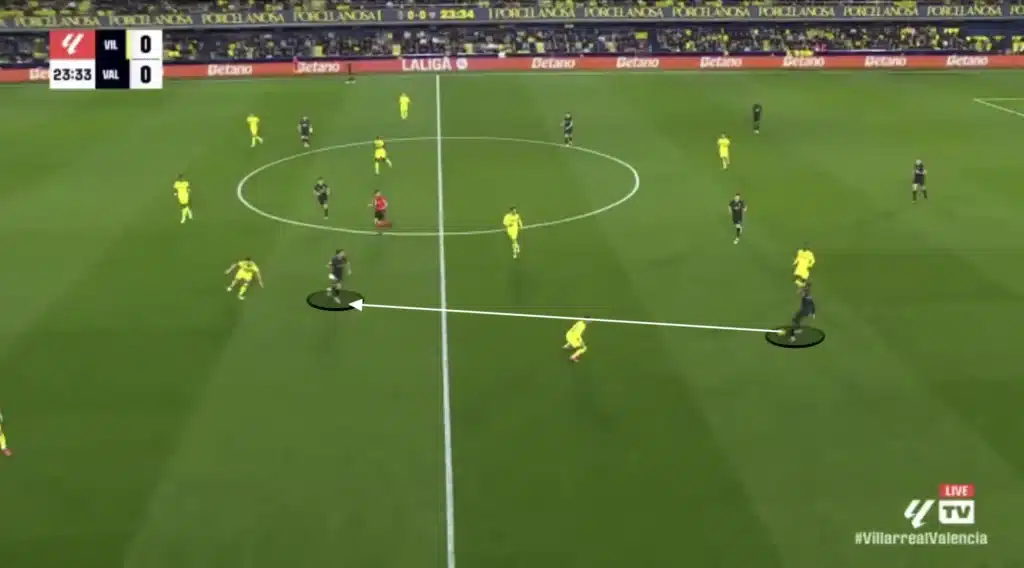
When receiving in these advanced pockets, the attacking midfielders are then in a prime position to link play with the forward line or switch the ball to the opposite side to exploit further space.
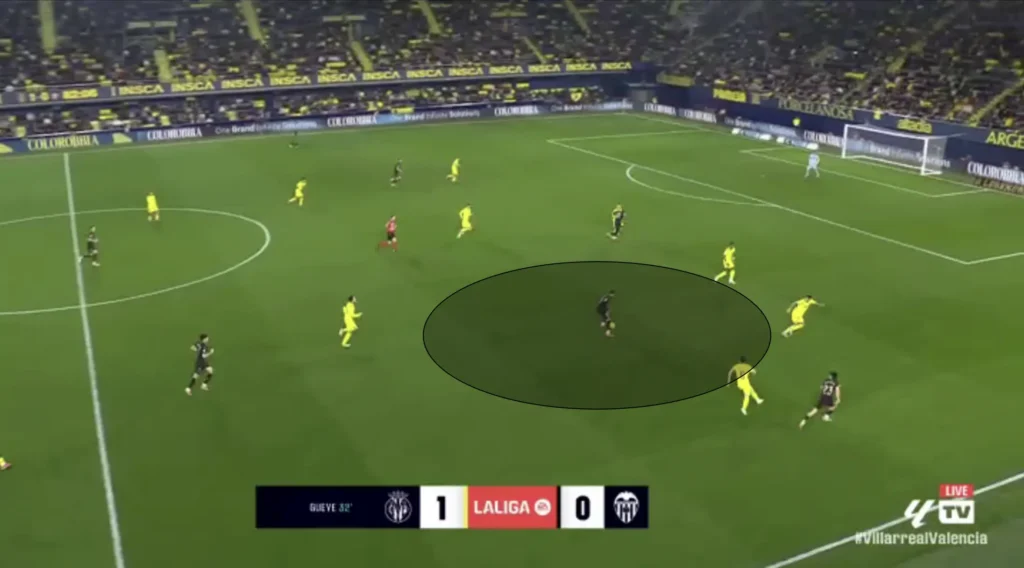
Corberán’s emphasis on using the wide center-backs as ball progressors highlights his commitment to fluid, dynamic build-up while maintaining numerical superiority through central positioning.
Defending
Corberán’s Valencia uses a 1-5-4-1 formation in the low press. They look to set up in a low-block, always trying to close the center and force the opposition out wide.
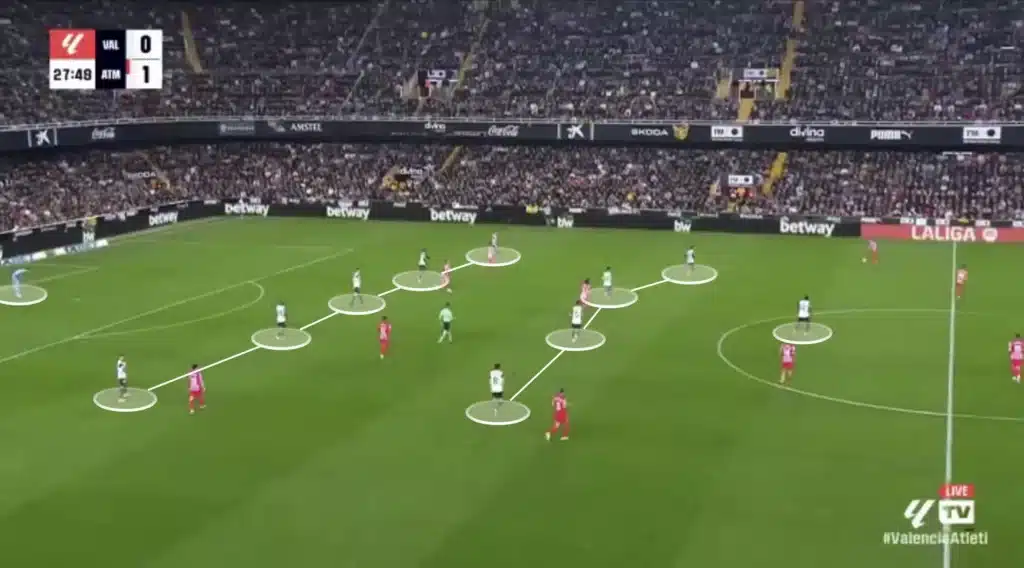
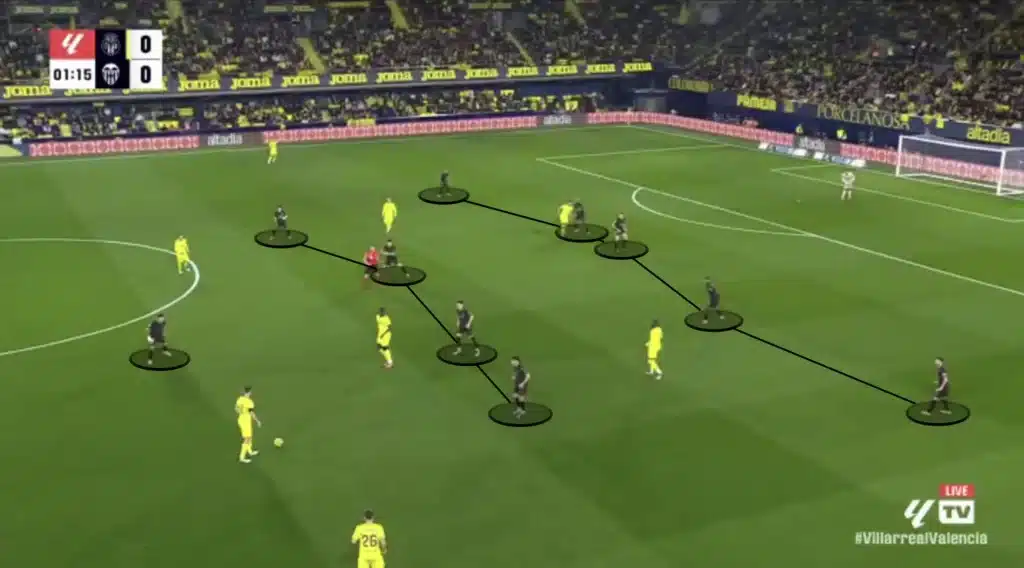
Defending in a 1-5-4-1 formation emphasizes solidity and compactness, making it particularly effective against teams that rely on wide play or quick transitions. The five defenders, including three center-backs and two wing-backs, create a strong defensive line that can absorb pressure and cover the width of the pitch. The four midfielders in front of the backline provide an additional layer of protection, often pressing the ball and cutting off passing lanes, while also helping to maintain the team’s shape. The lone striker remains higher up the field and usually tries to push the opposition to one side. This formation aims to limit the opposition’s space, forcing them to take risks or attempt crosses, which can be more easily defended with the numbers in the box.
While Corberán’s Valencia primarily defends in a compact 1-5-4-1 formation, they often adapt by pushing one of the central midfielders up to apply pressure on the opposition’s ball carrier. This proactive move is aimed at preventing the team from becoming too passive and allowing the opponent to build up momentum.
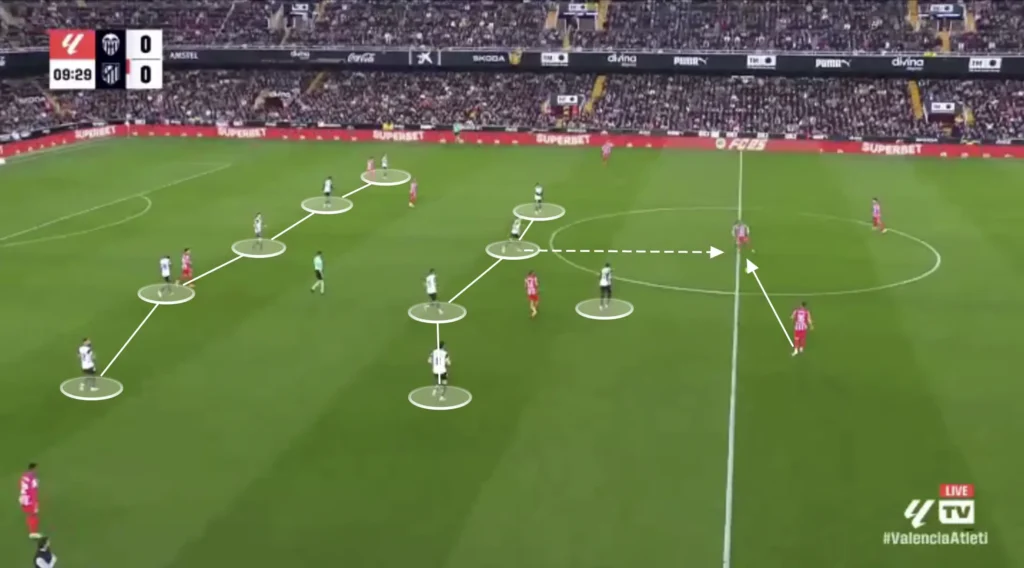
When the central midfielder advances, the remaining midfielders quickly adjust by dropping deeper to cover the space left open. This coordinated movement temporarily shifts the defensive shape to a 1-5-3-2 formation. The remaining midfield trio maintains compactness, ensuring that central areas remain well-protected while also being prepared to shift horizontally to cover wide threats.
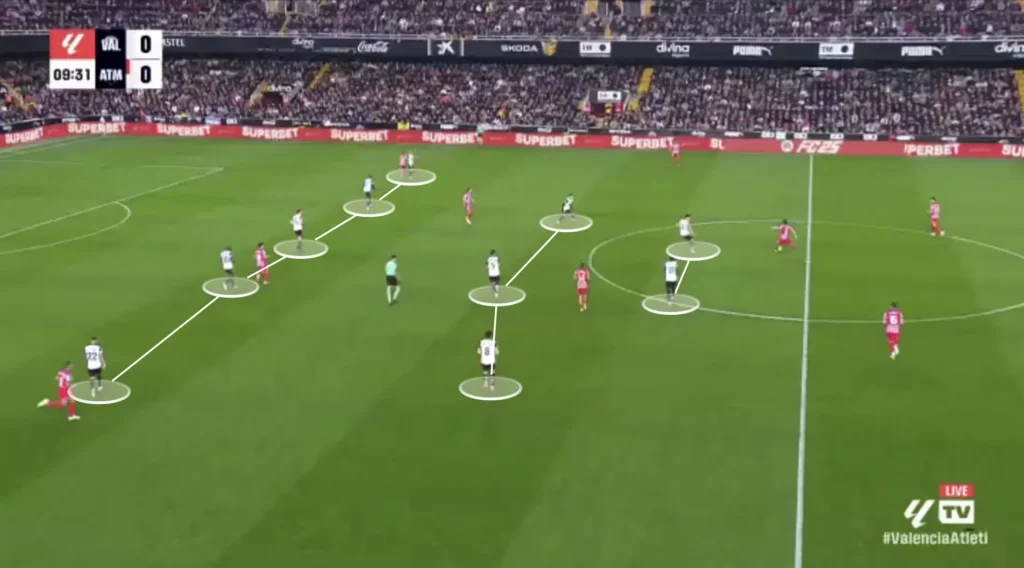
High Press
Man-to-Man
Corberán also implements a high-pressing system designed to disrupt the opposition’s build-up and force turnovers in dangerous areas. Their pressing structure will depend on the opposition, but they usually press in an aggressive man-to-man system. Each player is assigned a direct opponent to mark tightly, ensuring no easy passing options are available.
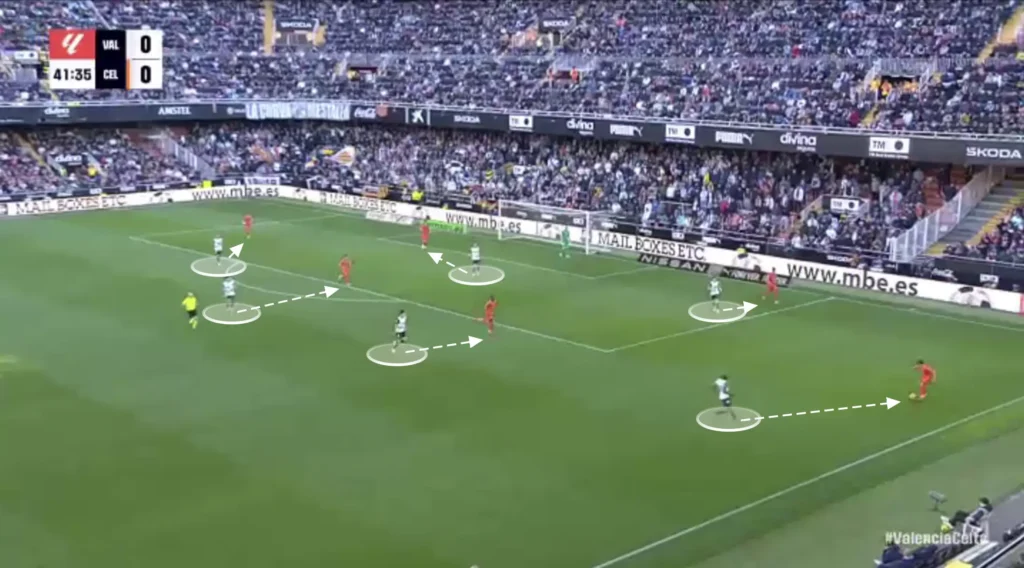
This intense pressure forces the opposing team into hurried decisions, often resulting in turnovers in dangerous areas. Valencia almost use this high press as an attacking threat, scoring many goals from winning the ball high up the pitch.
In a man-to-man system, it becomes crucial that the players know when to mark the opponent they are responsible for and when not to. If an opponent, for example, is very far from the ball, the Valencia player marking him does not need to be as close to him. He can instead come in and help create numerical superiorities in the center, decreasing the risk of dangerous 1v1 situations. Here, the ball is on the left side, which means the players on the right side can come into the middle and leave their opponents more open.
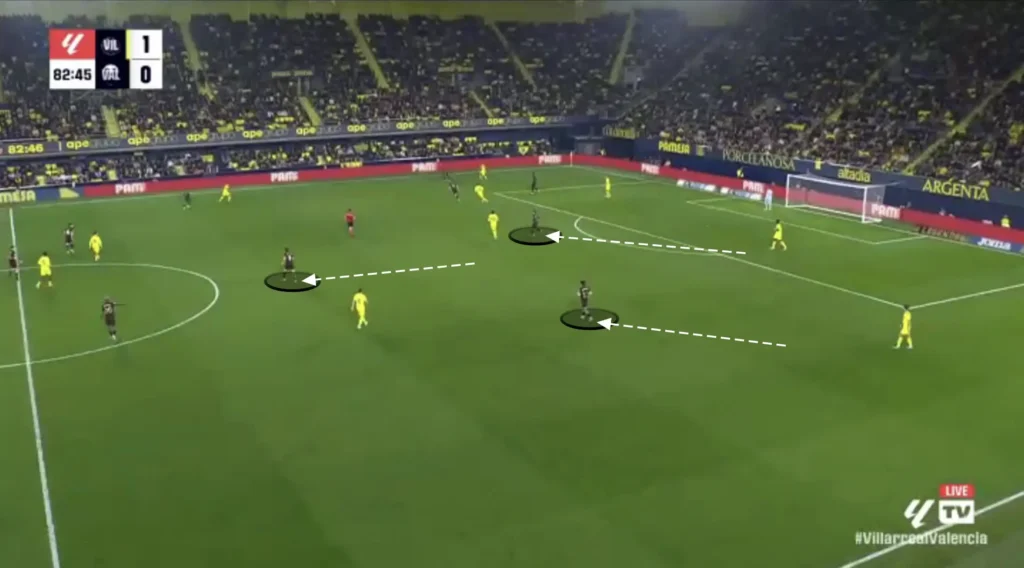
The Valencia players will always have an opposition player they are responsible for. However, they will never be closer to them than they need to be. A rule of thumb for the players could be that the closer you are to the ball, the closer you need to be to your opponent. The further away you are from the ball, the further away you can be from your opponent.
High Press with Numerical Disadvantage
At times, Corberán’s Valencia adapts their high press by leaving one additional defender at the back, resulting in a numerical disadvantage in the attacking areas. This shift is often employed when the opposition is more direct, and Valencia need to ensure they don’t leave themselves too exposed to quick attacks. While this setup sacrifices some numbers higher up the pitch, it allows for greater defensive stability at the back.
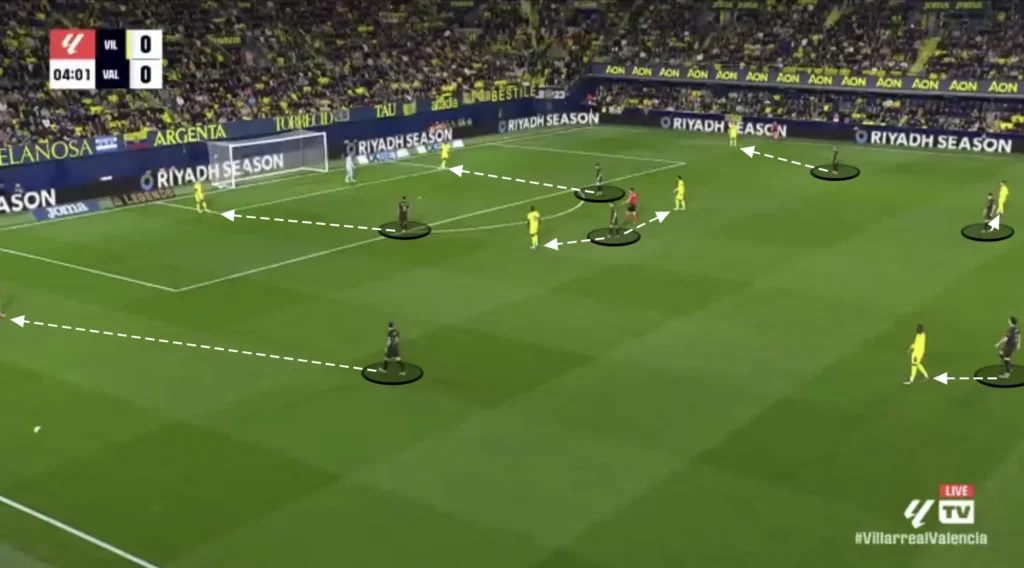
To compensate for this numerical disadvantage, Valencia’s pressing players must work even more cohesively and intelligently. Instead of relying on sheer numbers, they focus on making well-timed, angled pressing runs to close down passing lanes and force the opposition into uncomfortable positions. As the opposition progresses the ball, the Valencia players angle their runs to restrict passing options and push them toward one side of the pitch.
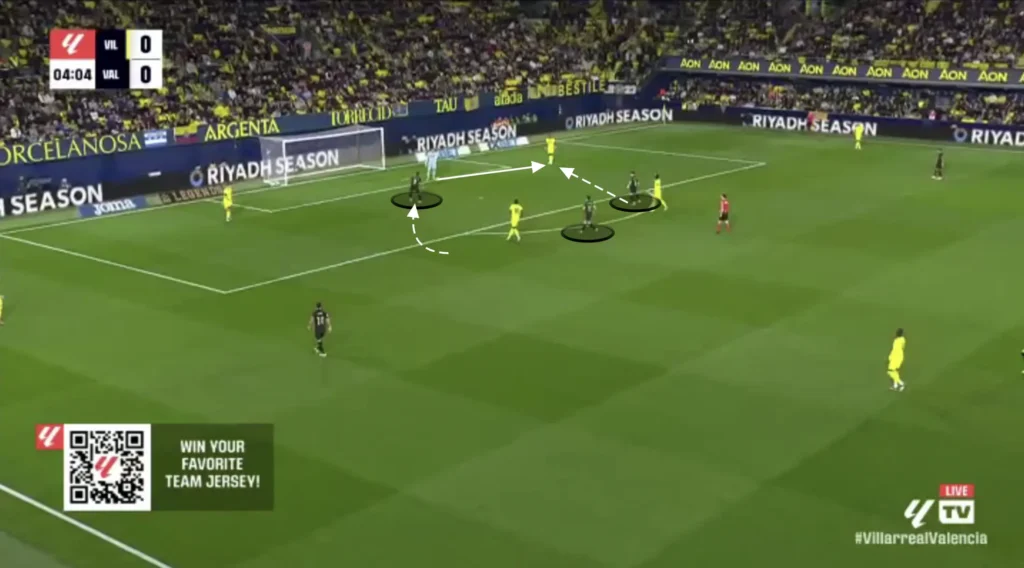
This coordinated movement aims to isolate the ball carrier and prevent the opposition from having multiple passing lanes available. Once the ball is funneled to one side, the pressing players work together to overload that side, closing down the space and creating a high-pressure environment that makes it difficult for the opponent to maintain possession.
Counterattacks
Under Carlos Corberán, Valencia have become a lethal counterattacking side, using their defensive solidity as a platform for rapid offensive transitions. As soon as possession is won, the team looks to break forward with speed and precision, exploiting gaps left by the opposition. The wingers and wing-backs provide immediate width, while the midfielders drive forward to support the lone striker. Corberán’s emphasis on verticality ensures that Valencia attack with purpose, minimizing unnecessary passes and maximizing direct, goal-threatening movements. This aggressive transition play has made them a constant danger on the break, punishing teams that commit too many players forward.
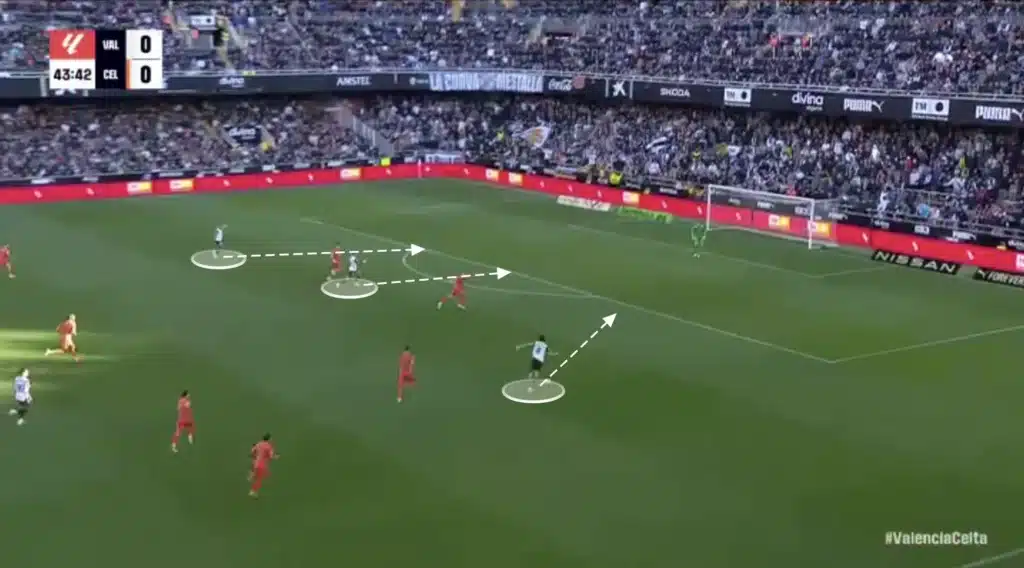
Final Thoughts
Carlos Corberán’s tactical approach at Valencia reflects his commitment to proactive and dynamic football. His emphasis on structured pressing, fluid build-up play, and attacking versatility has brought a fresh identity to the team. While there are still challenges to overcome—particularly in maintaining defensive solidity against high-quality opposition—Valencia’s progress under Corberán is evident.
As his ideas continue to take shape, it will be fascinating to see how the team adapts and evolves. If Corberán can strike the right balance between defensive stability and attacking ambition, Valencia may well find themselves competing at the top once again.
